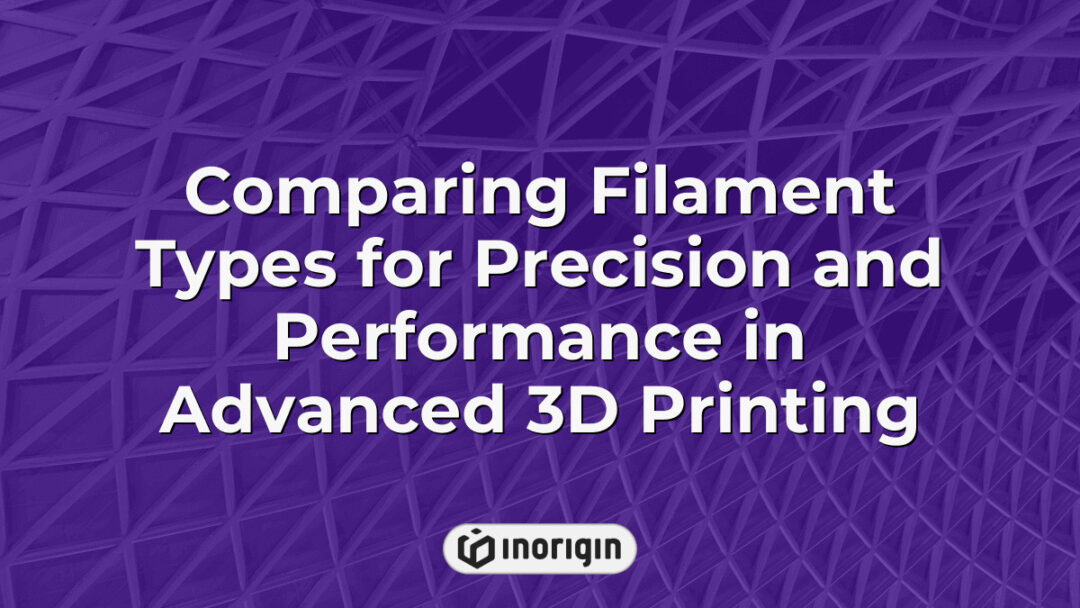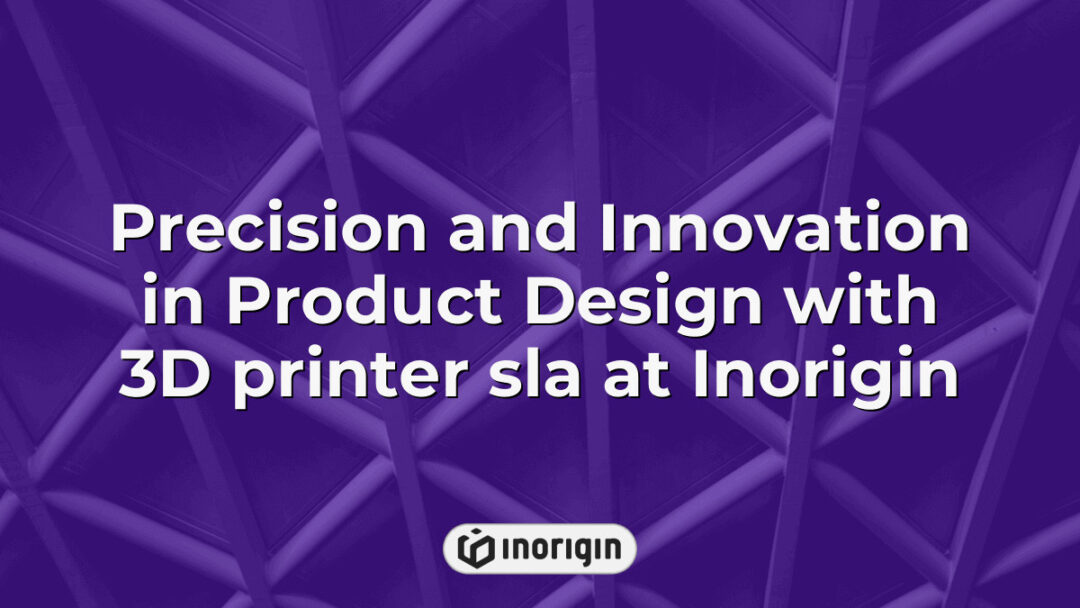In the vibrant and rapidly evolving world of 3D printing, the sheer diversity of filament types offers a captivating tapestry of possibilities, where innovation meets artistry in a dance of creativity and technology. Each filament, with its unique properties and characteristics, serves as a conduit for expression, enabling creators to transform imaginative concepts into tangible realities. From the robust resilience of PLA, reminiscent of nature’s bounty, to the luxurious sheen of PETG, which invokes the allure of refinement, the choice of filament profoundly influences the quality and durability of the final creation. This exploration into the myriad filament types not only highlights the technical nuances but also reveals the underlying artistry that fuels the passion of makers and designers alike.
| Aspect | Key Takeaway |
|---|---|
| Filament Types | The variety of filament types in 3D printing, including PLA, ABS, and PETG, allows designers at Inorigin to tailor product properties for durability and aesthetics. |
| Material Characteristics | PLA offers biodegradability and ease of printing, while ABS provides high strength and heat resistance ideal for engineering applications. |
| Specialty Filaments | Advanced filaments like nylon and carbon fibre deliver enhanced toughness and rigidity, supporting innovative and functional product prototypes. |
| Eco-Friendly Options | Plant-based filaments like PLA reduce environmental impact, aligning with sustainable design practices in modern product engineering. |
| Choosing the Right Filament | Select filaments by evaluating mechanical performance, printing compatibility, and the intended product function to ensure optimal results. |
| Storage & Maintenance | Proper filament storage using desiccants and cool, dark environments preserves material integrity and print quality over time. |
| Safety Precautions | Utilizing personal protective equipment and ensuring adequate ventilation mitigates risks when handling filaments such as ABS or nylon during printing. |
Overview of Popular 3D Printing Filament Types
The world of 3D printing filament types resembles a bustling marketplace, where various materials vie for attention, each offering unique characteristics and applications. An overview of popular 3D printing filament types reveals a spectrum of choices including, but not limited to, standard filaments such as PLA, ABS, and PETG. These materials serve as the backbone of additive manufacturing, catering to different needs—from aesthetic projects to functional prototypes. PLA (Polylactic Acid), often celebrated for its ease of use and biodegradability, stands in contrast to the resilience of ABS (Acrylonitrile Butadiene Styrene), which is preferred for its impact resistance and strength. As one navigates these options, PETG (Polyethylene Terephthalate Glycol) emerges as a hybrid choice, combining the best of both worlds with its excellent durability and flexibility. Each type of filament has distinct thermal and mechanical properties that dictate its suitability for diverse applications, shaping the outcomes of the 3D printing process. Understanding these specific attributes allows for an informed selection, critical in achieving optimal results in various projects.
Comparison of Thermoplastic Filaments
When comparing thermoplastic filaments, the contrasts between PLA and ABS become starkly apparent. PLA, which is derived from renewable resources such as cornstarch or sugarcane, stands out for its ease of use and lower printing temperature. Conversely, ABS, a petroleum-based plastic, is recognised for its strong mechanical properties and higher heat resistance, making it a preferred choice for more robust applications. While PLA is biodegradable, providing an environmental edge, its susceptibility to moisture absorption poses limitations; ABS, on the other hand, faces challenges during printing due to its tendency to warp yet remains favoured for items requiring durability. This juxtaposition highlights not just the differences in materials but also the distinct applications for which each filament is typically chosen. As trends in 3D printing evolve, the decision between PLA and ABS increasingly hinges on specific project requirements, with users weighing factors like strength, flexibility, and ecological impact against their intended purpose. Ultimately, the selection between these two filament types encompasses much more than mere preference; it becomes a reflection of the desired end-use characteristics and practical considerations inherent in the 3D printing process.
Specialty Filament Options and Their Applications
The exploration of specialty filament options and their applications reveals a diverse array of materials, showcasing unique properties that extend the capabilities of 3D printing. Firstly, specialty filaments such as nylon, carbon fibre, and PETG demonstrate varying thermal resistance, flexibility, and strength, catering to distinct industrial needs. Secondly, these advanced materials frequently feature additives that enhance their performance, making them suitable for various environments—from high-stress mechanical components to intricate artistic designs. Finally, some filaments are designed for specific applications, encompassing everything from bio-compatible materials for medical uses to filaments infused with metal or wood for aesthetic effects.
1. Nylon filaments offer exceptional toughness and impact resistance, making them ideal for engineering prototypes.
2. Carbon fibre filaments provide added rigidity and strength, suitable for lightweight aerospace or automotive components.
3. PETG combines the ease of printing with a degree of flexibility and chemical resistance valuable for functional prototypes.
By utilising these specialty filaments, designers and engineers can push the boundaries of traditional manufacturing techniques, leading to innovative solutions that were not previously attainable. The versatility of these materials continues to proliferate, illustrating the ongoing evolution in 3D printing technology. The implications of these advancements are substantial, influencing sectors ranging from healthcare to automotive engineering, and the potential applications appear endless as new materials are constantly developed.
Eco-Friendly Filament Alternatives
In recent years, the growth of eco-friendly filament alternatives has been remarkable, with statistics indicating that the market for bioplastics is expected to reach over $20 billion by 2025. This growing demand arises from a heightened awareness of environmental issues, leading both manufacturers and consumers to explore sustainable options. Eco-friendly filaments, such as those derived from renewable resources, present various advantages for 3D printing applications; these include:
- Reduced carbon footprint compared to traditional materials
- Biodegradability, which allows for easier disposability
- Lower energy consumption during production
- Compatibility with popular 3D printers, like those using PLA
These characteristics make eco-friendly filaments enticing to a diverse audience, particularly educators and hobbyists, who aim to minimise environmental impact while engaging in creative projects. PLA, a widely used eco-friendly filament, stands out due to its plant-based origins, making it suitable for a range of applications, from prototyping to intricate artistic designs. This filament not only caters to sustainability goals but also delivers quality outputs, proving that eco-conscious choices can coalesce with performance and aesthetics. As the narrative surrounding 3D printing evolves, the integration of these eco-friendly materials signals a significant shift towards more responsible production practices, opening up pathways for innovative solutions in various sectors. The trajectory towards sustainable materials in printing not only raises awareness but also enhances the potential for ecological mindfulness in technology-driven industries.
Choosing the Right Filament for Your Project
Choosing the right filament for a 3D printing project might seem straightforward; however, the extensive variety of filament types available today presents an ironic twist. Many enthusiasts approach the process with an overwhelming sense of confidence, only to discover that their initial choices are often misguided, leading to printing failures or unsatisfactory results. Therefore, an informed selection must incorporate several critical factors. For instance, consideration should be given to each filament’s mechanical properties, compatibility with the printing technology in use, and environmental implications.
- Key Filament Types to Consider:
- Common 3D Printing Filaments:
- PLA: Known for its ease of use and biodegradability.
- ABS: Favoured for its strength but poses challenges with warping.
- Specialised Filaments:
- PETG: Combines ease of printing with durability; good for functional parts.
- TPU: A flexible filament ideal for rubber-like applications.
The intricate balance between functionality and suitability dictates that both novice and experienced users must remain cautious in their decisions surrounding supported filament types. For example, while PLA presents a user-friendly option for beginners, the shift to PETG might be necessary for projects requiring enhanced toughness. Ultimately, the choice of filament profoundly impacts both the aesthetic and mechanical properties of the printed object; hence, careful evaluation leads to superior outcomes in the realm of 3D printing.
Frequently Asked Questions
What are the best practices for storing 3D printing filaments?
The preservation of 3D printing filaments is a topic that may seem straightforward but, beneath its surface, lies a complexity often overlooked by practitioners. To ensure optimal performance and longevity of the materials, one must first consider the environmental influences that these filaments are subjected to over time. Humidity, for instance, can gravely impact filament integrity; hygroscopic materials, like PLA, tend to absorb moisture, which can lead to print failures and compromised mechanical properties. Consequently, employing dry storage solutions—such as desiccant containers or vacuum-sealed bags—is advisable to mitigate such risks. Additionally, temperature control plays an essential role; filaments should ideally be stored in a cool, dark place to prevent thermal degradation. Beyond storage techniques, one should also take into account the manner in which filaments are organized; clearly labelled, vertically stored spools not only save space but also allow for quick access, thereby reducing the likelihood of damage during handling. These practices, when meticulously adhered to, significantly contribute to the overall quality and success of 3D printing endeavors, ensuring that each print can meet the desired specifications without unforeseen complications.
How do different filament types affect print cooling and layer adhesion?
Different types of 3D printing filaments can be likened to a painter’s palette; each filament offers unique characteristics that dramatically influence the final output. This metaphor highlights the importance of understanding how these materials interact with one another and with the printing process itself. The varying cooling rates and layer adhesion properties dictate not only the aesthetic appeal but also the structural integrity of the 3D printed objects. For instance, materials such as PLA (Polylactic Acid) tend to cool rapidly and adhere well layer-to-layer, creating robust prints. In contrast, ABS (Acrylonitrile Butadiene Styrene) benefits from slower cooling, reducing the risk of warping but potentially complicating adhesion between layers. By examining the properties of specific filament types, one can elucidate their implications for print quality and durability.
Key factors influencing print performance include:
- Cooling rate, which can affect layer adhesion; rapid cooling may lead to delamination, while slower cooling often enhances adhesion.
- Filament composition, as materials like nylon may require additional preparation such as drying before printing, thus modifying adhesion characteristics.
- Print temperature, which varies significantly between filaments and influences both the flow and adhesion of the material layers.
Understanding the interplay of various filament types is essential in optimising the 3D printing process. By carefully selecting materials based on their thermal properties and cooling behaviours, practitioners can significantly enhance the quality of their prints. This informed approach does not simply ensure aesthetic appeal but also prioritises the strength and longevity of the final product. Therefore, recognising the nuanced interactions between filament characteristics and print dynamics serves as a foundation for advancing 3D printing applications across diverse fields.
What safety precautions should be taken when working with various 3D printing filaments?
When working with various 3D printing filaments, adherence to specific safety precautions is paramount to ensure not only the health of the individuals involved but also the integrity of the printing process itself. First, appropriate personal protective equipment (PPE) must be worn; this typically includes gloves, safety goggles, and masks, especially when dealing with materials such as ABS and nylon, which can emit harmful fumes during printing. In addition to PPE, proper ventilation in the work area is essential; this can be achieved through the use of fume extractors or ensuring that the space is well-ventilated to dissipate potentially toxic vapours. Furthermore, understanding the flammability of certain filaments—like PLA, which is relatively low risk, versus others such as PVA which may pose greater hazards—is crucial. Concurrently, the storage of filament should be managed carefully; moisture-sensitive materials necessitate desiccants or sealed containers to prevent degradation. Given the diversity of materials available, which ranges from common thermoplastics to more specialised composites, awareness of specific material safety data sheets (MSDS) is vital, as they outline the hazards and first-aid procedures associated with each filament type. Through a systematic approach to safety, risks inherent in 3D printing can be mitigated significantly, promoting a more secure and efficient working environment.
Conclusion
In conclusion, the selection of the appropriate 3D printing filament parallels a well-crafted recipe, where each ingredient contributes to the final outcome. By understanding the diverse characteristics of various filaments, including thermoplastic and eco-friendly options, optimal results can be achieved, leading to successful project completion and innovation in design.
Related posts:
- Material Science and Performance Standards Shaping 3D Printer Filament Quality
- Why PETG 3D Printer Filament Excels in Strength and Versatility for Advanced Prototyping
- 3D printing filament petg performance characteristics for precision prototyping and manufacturing
- 3D printer filament types That Enhance Strength, Flexibility, and Finishing for Professional Prototypes
- Eco Friendly Packaging Innovations Transforming Sustainable Product Design
- Advanced 3D Print Filament Properties and Sustainable Options for Precision Prototyping




